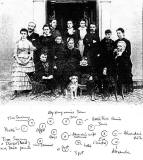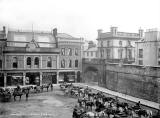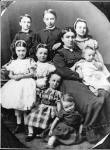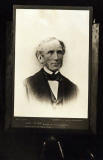|
EPS Wednesday Meeting 1 March 1882 |
|
Some Photographic Experiences including Enamelling and a recent discovery for the Fixing of Silver Plates Alexander Ayton |
|
Dry Plates Alexander Asher mentioned that the subject of dry plates was engrossing much interest in 1882. He said that he had first encountered dry plates about 25 years ago. He believed these were called collodio-albumen, but he was very disappointed with the results, so he had nothing more to do with dry plates until now. He said: "I commenced with plates by Messrs Wratten and Wainwright, and had considerable success, especially with pictures of children. By-and-bye the rejected plates began to accumulate to such an extent that the question arose - What is to be done with them? After a good deal of consideration, I determined to make my own emulsion and re-coat them." After some initial difficulties with the gelatine not setting in the hot summer of 1880, Alex Ayton was successful. He then described his latest method, one which he had not seen published: "I prepare the material for 20 ounces by the alkaline process (that is, with ammonio-nitrate of silver) and 20 ounces, by the acid method, boiling for 10 or 12 minutes. Neither of these , so treated, would separately yield a rapid plate; but by mixing both together with the excess of gelatine, allowing it a night to set and afterwards washing thoroughly, I obtain an emulsion of the very highest sensibility and certainty." He also referred to refer to other methods he had used - including the formulae by DR Elder and WB Bolton, and the method which he found to give the best results, using ammonium bromide for the alkaline method and potassium bromide for boiling, mixing both together with the full quantity of gelatine. |
|
Enamelling Alexander Ayton discovered his method of enamelling by accident. It consisted of the following stages, which I have set out in the form of a table: Prepare the plate - clean the plate - finish with wash leather, no talc or French chalk - coat with plain collodion - put on a rack until dry - varnish with a white lac varnish Prepare the print - wash the prints all night so they are tolerably free of soda - dry the prints -
immerse the prints with a glass rod, one at a time in a solution of 2
volumes of sulphuric acid to one of water -
wash again, adding a few drops of ammonia to the last water For prints to be finished with a matt surface - cut to size - tone - mount while wet with gelatine [starch is no use] - burnish in the usual way [if desired] Carte-sized prints for enamelling - coat on the back with gelatine - pin up till dry - cut to size - mount upon thin Bristol board - touch up the spots and rectify any defaults with Indian ink [If the prints are to be coloured, use water colours, but without gum or any other medium] - coat with thin collodion - soften with hot water - float with a weak solution of gelatine on to the varnished plate which sets immediately - put up in an airy place till the next morning - when dry, strip the prints off the glass |
|
Closing Remarks Alex Ayton then gave a full description of other methods he had used. He closed his lecture with the following remarks: "While upon this subject, I cannot refrain from expressing my dislike of secret processes, whether genuine or otherwise. It has not been by secrecy that photography has progressed so far, nor will the process-monger add much to its progress in the future ... By these remarks I endeavour to repay in some measure the many useful hints I have received from this and kindred associations" |
|
Ayton Photographers More Pages |
||
|
Alexander Ayton Sen |
||
|
Alexander Ayton Jun |
Edinburgh studios family lectures |
|
|
Edinburgh, Leith, Portobello |
||
|
Edinburgh Photographic Convention - 1892 |
||




